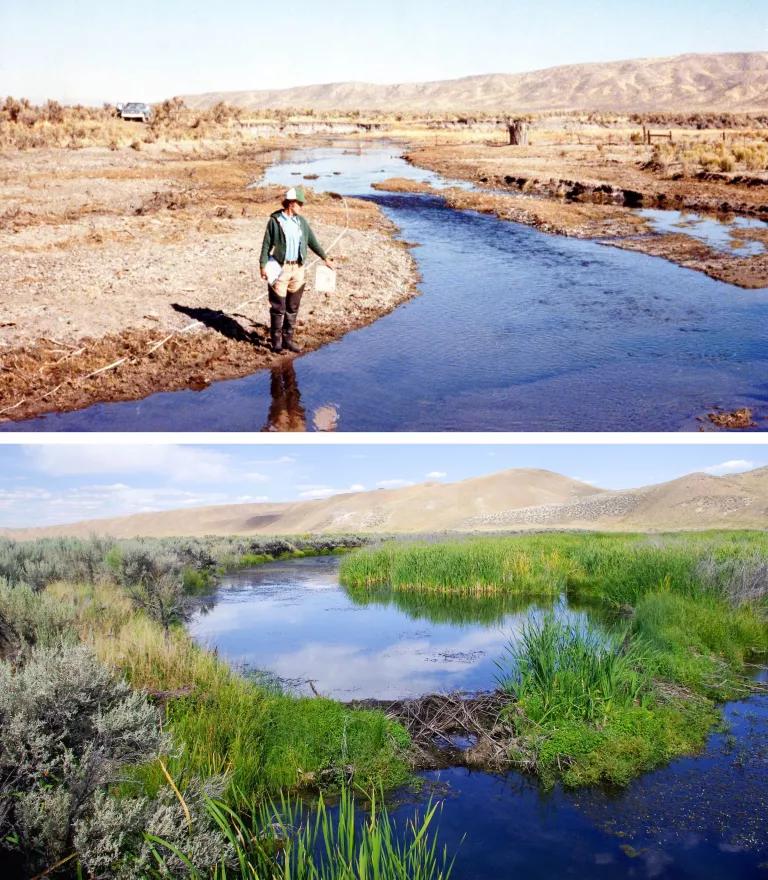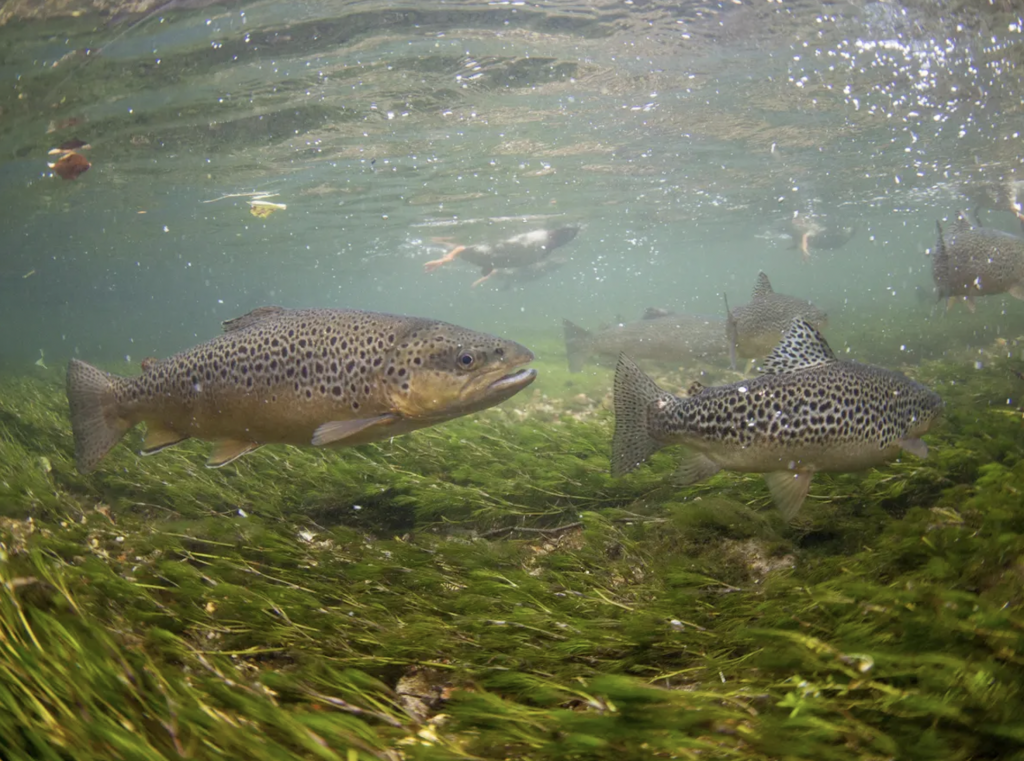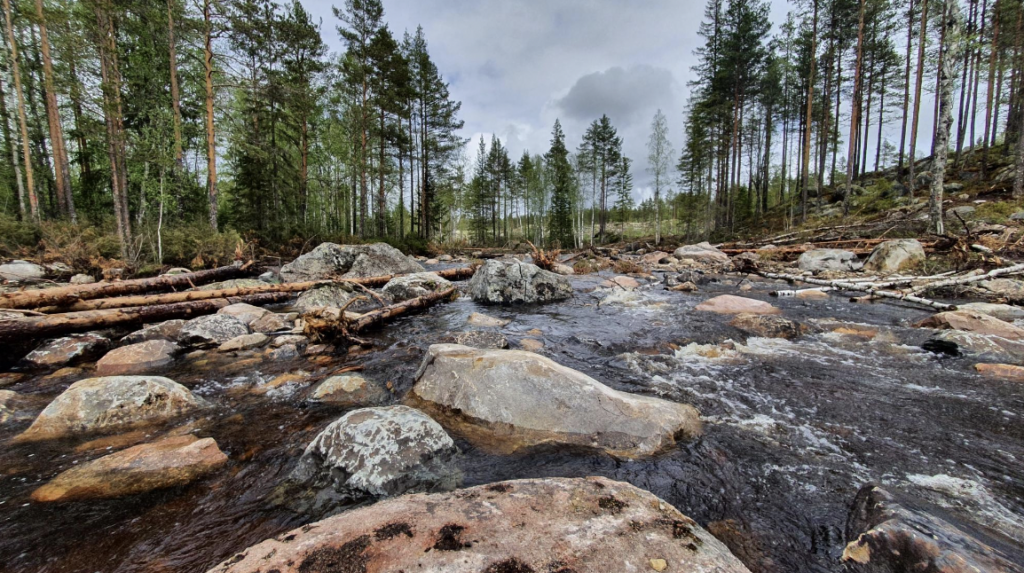Beavers (Castor fiber or Castor canadensis) can have widespread impacts on ecosystems due to their life history habits. They are commonly known as an “ecosystem engineer” species and can modify stream aquatic ecosystems drastically while meeting their own needs. Through habits such as felling trees to digging canals, beavers can change the abiotic, or non-living, components of these aquatic ecosystems (Brazier et al., 2020).
Beaver-induced changes can alter the shape, speed, and sediment distribution within a stream (Naiman et al., 1986) These changes in abiotic components of stream ecosystems can, in turn, affect the biotic, or living, components, such as fish communities. For example, fish species richness and population health can be related to stream features such as depth and level of structure (Lonzarich & Quinn, 1995).

Changes in the appearance of Maggie Creek, Nevada following stream restoration efforts including the reintroduction of beavers (NRDC, 2024)
This post will summarize and examine the impacts of beaver ecosystem modifications on fish communities as found in the study “Effects of beaver dams on the fish fauna of forest streams” by Åsa Hägglund and Göran Sjöberg.
Streams in Sweden were sampled to understand what impacts beavers may have had. Beavers were once extinct in Sweden due to hunting and demand for beaver pelts. Beavers from Norwegian populations were reintroduced to Sweden from 1922 to 1939. The reintroduction was highly successful, and by 1992, there were about 1992 beavers throughout the country (Hartman, 1995). These unprecedented changes in the abundance of such an influential species had widespread effects on other species.
Beavers’ effects on five fish species were evaluated. The species were minnow (Phoxinus phoxinus), brown trout (Salmo trutta), bullhead (Cottus gobio), burbot (Lota lota), and pike (Esox Lucius). A total of seven streams were sampled using electrofishing. The majority of streams sampled were second-order, though one third-order and one fourth-order stream were included. The stream areas were divided into categories based on their proximity to beaver ponds. The categories were riffles upstream of a beaver pond, a beaver pond (including the dam), and a riffle downstream of the pond. In addition to these categories, “reference” sections, or areas further from beaver ponds. The streams were sampled three times in a span of four months, except for the fourth-order stream, which was sampled only twice. The species were minnow (Phoxinus phoxinus), brown trout (Salmo trutta), bullhead (Cottus gobio), burbot (Lota lota), and pike (Esox Lucius). Each individual caught was measured for length. Larger, lentic species, specifically Brown Trout were predicted to be more frequently found in the beaver ponds while lotic species were predicted to be more frequently found in the riffles.
The most fish were collected in the reference sections (281 fish) followed by beaver pond sections (242 fish) and downstream riffles (107 fish). The least fish were collected in upstream riffles (60 fish). The majority of fish collected were minnows (417 fish). Brown trout were the second most collected, (249 fish), while burbot were collected the least (1 fish).
These results supported the hypothesis that lentic fish overall would be found more frequently in beaver ponds. However, the prediction that brown trout would follow this pattern was not supported, as they were found more frequently in riffle patterns. The authors suggested that this may be due to changes in trout feeding patterns over their life cycle, with younger trout using faster-moving stream sections more frequently than ponds (Alexander & Hansen, 1983). This suggestion was supported by the results because larger trout individuals were collected in the pond areas.

Brown trout in a stream habitat. (The Guardian, 2019)
The study concluded that beaver habits such as creating dams can increase species diversity in streams overall due to an increase in habitat diversity. Dams can act as a barrier against fish migration, though the actual observed effect of this can vary based on the dispersal habits of the species.
However, as the title of the study suggests, it is not a comprehensive study. Based on the specificity of the focus streams, caution is advised before applying these results to other locations.
Only boreal, coniferous forest streams were studied. Additionally, only Swedish streams were studied, which the authors noted may impact the results because Sweden is species-poor compared to areas such as North America. These results should be compared to the findings of similar studies in other regions to understand how regional species composition and diversity may impact beaver-fish interactions.

A coniferous stream in Sweden (Countryboard of Gävleborg, 2022).
References
“Country Diary: Beneath the Gin-Clear Waters of the Test.” 1995. The Guardian. https://www.theguardian.com/environment/2019/jul/04/country-diary-trout-beneath-the-gin-clear-waters-of-the-river-test.
Hartman, Göran. 1995. “Patterns of Spread of a Reintroduced BeaverCastor Fiberpopulation in Sweden.” Wildlife Biology 1 (1): 97–103. https://doi.org/10.2981/wlb.1995.0015.
Naiman, Robert J., Jerry M. Melillo, and John E. Hobbie. 1986. “Ecosystem Alteration of Boreal Forest Streams by Beaver (Castor Canadensis).” Ecology 67 (5): 1254–69. https://doi.org/10.2307/1938681.
Sherry, Jennifer, and Minah Choi. 2021. “How the Eager Beaver Helps Protect the Planet.” NRDC. https://www.nrdc.org/bio/jennifer-sherry/how-eager-beaver-helps-protect-planet.
“Sweden’s Rivers Get a New Lease of Life.” 2022. European Climate, Infrastructure, and Environment Executive Agency. https://cinea.ec.europa.eu/news-events/news/swedens-rivers-get-new-lease-life-2022-11-18_en.